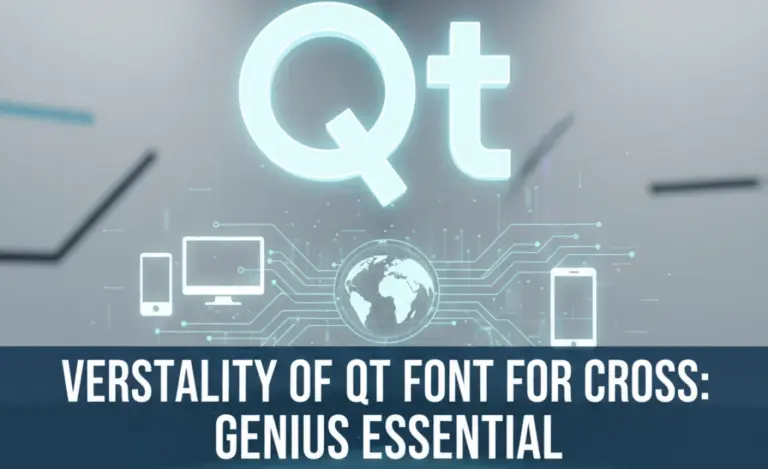The Power of Font Awesome NPM lies in easily integrating a vast library of high-quality icons into your web projects, streamlining development and enhancing user experience without manual file management.
Web projects often need that perfect little icon to bring a design to life. Whether it’s a social media link, a navigation button, or just a way to make text more engaging, icons are essential. But managing icon files can quickly become a headache. You might download a pack, only to find you need another, or struggle with different file formats. It’s frustrating when something so small can cause so much hassle! Thankfully, there’s a smarter way. We’re going to explore how leveraging Font Awesome through NPM can transform how you add icons to your projects, making it simpler, faster, and more dynamic. Get ready to unlock a world of visual storytelling!
What is Font Awesome NPM?
Font Awesome is a hugely popular icon set and toolkit. Think of it as a massive digital library filled with thousands of ready-to-use icons, covering everything from social media and arrows to user interfaces and brand logos. These icons help make your websites and applications more visually appealing and easier to navigate.
Normally, you might add icons to your website by downloading image files (like PNGs or SVGs) or by linking to a Font Awesome stylesheet directly from their CDN (Content Delivery Network). But when you’re building applications, especially with modern JavaScript frameworks like React, Vue, or Angular, there’s a more integrated and efficient approach: using Font Awesome via NPM.
NPM, which stands for Node Package Manager, is the default package manager for Node.js. It’s the world’s largest software registry. Essentially, NPM allows developers to easily install, share, and manage code packages, including Font Awesome. When you use Font Awesome with NPM, you’re installing it directly into your project’s dependencies, giving you more control and flexibility.
Why Use Font Awesome NPM for Your Projects?
The “power” of Font Awesome NPM really shines when you compare it to older methods or just using the CDN. It’s not just about having access to icons; it’s about how you integrate and manage them. Here’s why it’s a game-changer:
Seamless Integration with Build Tools
Most modern web development workflows use build tools like Webpack, Parcel, or Vite. These tools are designed to bundle your project’s code, including JavaScript, CSS, and assets. When you install Font Awesome via NPM, these build tools can automatically detect and include the necessary icon files and styles in your final, optimized project bundle. This means fewer manual steps and a cleaner workflow.
Version Control and Dependency Management
Using NPM means Font Awesome becomes a dependency of your project. You can specify which version of Font Awesome you want to use. This is crucial for maintaining consistency across different development environments and for ensuring that your project works with a specific set of assets. If a new version introduces breaking changes, you have full control over when to update, rather than being subject to CDN updates immediately.
Offline Access and Performance
Once installed via NPM, Font Awesome’s files are part of your project. This allows for offline development and can sometimes lead to faster loading times, as assets are served directly from your own server or bundled application, reducing external network requests. Your users’ experience is less dependent on external server availability.
Customization and Tree Shaking
Modern Font Awesome NPM packages are designed to work with tree shaking. This is a process where your build tools eliminate unused code. If you only use a few specific icons, tree shaking can ensure that only those icons (and their associated code) are included in your final bundle, making your project smaller and faster. This level of optimization is harder to achieve with a simple CDN link.
Component-Based Development
For frameworks like React or Vue, Font Awesome offers specific NPM packages that provide components. This means you can use icons like you would any other UI element – as a self-contained component. For example, in React, you might import “, making your code more readable and manageable.
Access to All Features
Whether you’re using SVG, CSS, or a framework-specific component, NPM provides access to the full range of Font Awesome’s features, including brand icons, solid icons, regular icons, and even custom icon integration.
Getting Started with Font Awesome NPM
Ready to add some pizzazz to your project? Here’s a step-by-step guide to get you rolling with Font Awesome using NPM. We’ll assume you already have Node.js and NPM installed on your system. If not, you can download them from the official Node.js website: Node.js Downloads.
Step 1: Initialize Your Project (or Navigate to It)
If you’re starting a new project, you’ll need to initialize NPM. Open your terminal or command prompt, navigate to your project folder, and run:
npm init -y
This command creates a `package.json` file, which keeps track of your project’s metadata and dependencies. The `-y` flag automatically accepts default settings.
If you already have a project set up, simply navigate to its root directory in your terminal.
Step 2: Install the Font Awesome NPM Package
Font Awesome offers different packages depending on how you want to use it. The most common and versatile is the SVG with JavaScript package. This method allows for easy manipulation of icons and works well with modern bundlers.
To install it, run the following command in your terminal:
npm install @fortawesome/fontawesome-svg-core @fortawesome/free-solid-svg-icons @fortawesome/free-regular-svg-icons @fortawesome/free-brands-svg-icons @fortawesome/react-fontawesomeNote:
@fortawesome/fontawesome-svg-core: The core library.@fortawesome/free-solid-svg-icons: For solid style icons.@fortawesome/free-regular-svg-icons: For regular (outline) style icons.@fortawesome/free-brands-svg-icons: For brand-specific icons (like Facebook, Google, etc.).@fortawesome/react-fontawesome: If you are using React, install this for a convenient React component. (Similar packages exist for Vue, Angular, etc.)
If you only need specific icon styles, you can install them individually. For example, to only use solid icons with React, you might install:
npm install @fortawesome/fontawesome-svg-core @fortawesome/free-solid-svg-icons @fortawesome/react-fontawesomeStep 3: Import and Use Icons in Your Code
The way you use icons depends on your project setup and framework. Here are examples for common scenarios:
Using Font Awesome in React with `react-fontawesome`
This is the recommended approach for React projects. First, import the necessary components and icons into your React component:
import React from 'react';
import { FontAwesomeIcon } from '@fortawesome/react-fontawesome';
import { faCoffee } from '@fortawesome/free-solid-svg-icons';
import { faTwitter } from '@fortawesome/free-brands-svg-icons';
function MyComponent() {
return (
<div>
<p>
I need my coffee
<FontAwesomeIcon icon={faCoffee} size="lg" />
</p>
<p>
Follow us on
<FontAwesomeIcon icon={faTwitter} />
</p>
</div>
);
}
export default MyComponent;In this example:
- We import `FontAwesomeIcon` from `@fortawesome/react-fontawesome`.
- We import specific icons (`faCoffee`, `faTwitter`).
- We use the “ component, passing the icon object to the `icon` prop.
- You can also control `size`, `color`, `spin`, and other properties directly on the component.
Using Font Awesome with Vanilla JavaScript (or other frameworks indirectly)
For projects not using React, or if you prefer a more direct SVG approach, you can use the `fontawesome-svg-core` library directly. This often involves importing icons and using a function to render them as SVG elements.
import { library, dom } from '@fortawesome/fontawesome-svg-core';
import { faCoffee } from '@fortawesome/free-solid-svg-icons';
import { faTwitter } from '@fortawesome/free-brands-svg-icons';
// Add icons to the library
library.add(faCoffee, faTwitter);
// Render icons where needed.
// For example, you might have HTML like: <i class="fas fa-coffee"></i>
// and Font Awesome will convert it. Or you can render SVG manually.
// This often integrates with your build tool's output.
dom.watch(); // Automatically finds and replaces <i> tags with SVG iconsIn a typical setup with a build tool like Webpack, after installing and configuring, simply using an HTML `` tag with the correct classes (e.g., ``) might be enough for Font Awesome to render the SVG icon. Your build setup will handle bundling the necessary assets.
Using Font Awesome with Vue.js (Example)
For Vue, you’d typically use a package like `@fortawesome/vue-fontawesome`.
npm install @fortawesome/vue-fontawesome@^3.0.0Then in your `main.js`:
import { createApp } from 'vue';
import App from './App.vue';
import { FontAwesomeIcon } from '@fortawesome/vue-fontawesome';
import { library } from '@fortawesome/fontawesome-svg-core';
import { faUser } from '@fortawesome/free-solid-svg-icons';
library.add(faUser);
const app = createApp(App);
app.component('font-awesome-icon', FontAwesomeIcon);
app.mount('#app');And in your component template:
<template>
<font-awesome-icon :icon="['fas', 'user']" />
</template>Step 4: Configure Your Build Tool (If Needed)
In most modern setups (like Create React App, Vue CLI, or Vite), installing the NPM package is enough. The build tool will automatically pick up the assets. However, if you have a custom Webpack or other build configuration, you might need to ensure that SVG files and PostCSS (which Font Awesome uses for styling) are correctly processed. This usually involves setting up loaders and plugins for SVG and PostCSS.
For example, with Webpack, you might configure your `webpack.config.js` to handle CSS and SVG imports, which is often already set up in starter templates. You can find detailed configurations in the official Font Awesome documentation for specific build tools.
Step 5: Explore Icon Options and Styles
Font Awesome offers a vast collection of icons across different styles:
- Solid: Filled-in icons.
- Regular: Outline icons.
- Thin: Lighter weight outlines.
- Light: Also lighter weight, distinct from thin.
- Brands: Logos for popular companies and services.
You can also control icon size, rotation, stacking, and animation:
- Size: `xs`, `sm`, `lg`, `2x`, `3x`, `4x`, `5x`, `10x` are common.
- Spinning: Add a `spin` prop for animated rotation.
- Pulse: Add a `pulse` prop for a pulsing animation.
- Flip: `horizontal`, `vertical`.
- Rotate: `90`, `180`, `270`.
Check the official Font Awesome documentation for a complete list of icons and their usage. The Font Awesome Search page is your best friend here.
Font Awesome Icons vs. SVG Sprites
When discussing icons, it’s helpful to compare Font Awesome to another common method: SVG sprites. Both have their place, but Font Awesome NPM offers unique advantages.
| Feature | Font Awesome (NPM with SVG) | SVG Sprites |
|---|---|---|
| Icon Set | Massive, curated library provided by Font Awesome. Constantly updated. Easy to access new icons. | Custom SVG files you collect or create. Requires manual compilation/management for a large set. |
| Integration | Seamless with NPM and modern build tools. Framework-specific components available. | Can be integrated via build tools, but often requires more manual setup to combine SVGs. |
| Usage in Code | Simple component usage (e.g., `<FontAwesomeIcon icon={faCoffee} />`) or `` tags. Very declarative. | Uses `<svg><use xlink:href=”#icon-name”></use></svg>` which can be less intuitive for beginners. |
| Customization | Easy dynamic styling (color, size etc.) via props/CSS. | Requires SVG manipulation or CSS for styling individual icons. Dynamic styling can be more complex. |
| Performance | Bundled with project, potential for tree shaking to include only used icons. Minimal HTTP requests when bundled. | One HTTP request for the sprite sheet. Can be optimized, but might include unused icons if not managed carefully. |
| Maintenance | Updates handled by `npm update`. New icons added by Font Awesome are readily available. | Adding new icons requires updating the sprite source files and recompiling. |
| Learning Curve | Very beginner-friendly, especially with framework components. | Requires understanding SVG anatomy and sprite creation tools. |
Best Practices for Font Awesome NPM
To get the most out of Font Awesome NPM, follow these tips:
Use the SVG with JavaScript Package
This is the most flexible and modern way to use Font Awesome. It leverages the power of SVG for scalability and allows for fine-grained control and excellent integration with build tools, including tree shaking for performance.
Install Only What You Need
If you know you’ll only be using solid icons, you don’t need to install the `free-regular-svg-icons` or `free-brands-svg-icons` packages. This helps keep your project dependencies lean. For React/Vue/Angular specific packages, install the one relevant to


Leave a Comment